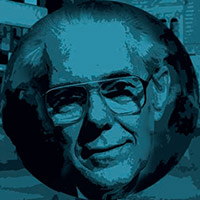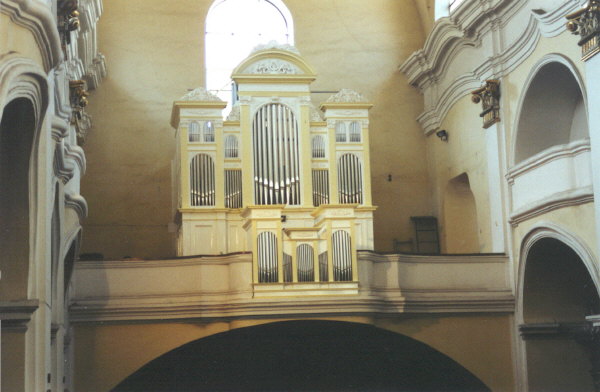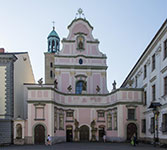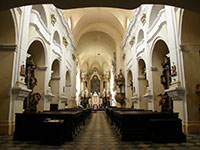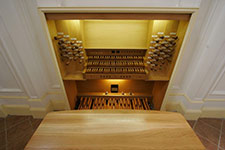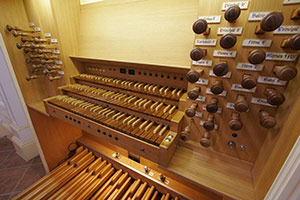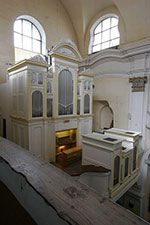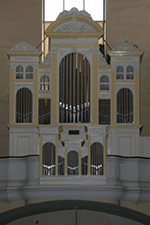Organ in the Church of the Holy Spirit in Opava
Václav Smolka, Opus 5
Disposition:
I. Manuál - Zadní pozitiv
C - a3
| 1 | Kryt | 8' |
| 2 | Principál | 4' |
| 3 | Flétna trubicová | 4' |
| 4 | Oktáva | 2' |
| 5 | Kvinta | 11/3' |
| 6 | Cimbál 4x | 1' |
| 7 | Roh křivý ■ | 8' |
| 8 | Tremolo |
II. Manuál - Hlavní stroj
C - a3
| 9 | Principál | 16' |
| 10 | Principál | 8' |
| 11 | Flétna trubicová | 8' |
| 12 | Roh kamzičí | 8' |
| 13 | Oktáva | 4' |
| 14 | Fugara | 4' |
| 15 | Kvinta | 22/3' |
| 16 | Oktáva | 2'' |
| 17 | Mixtura 4-5x | 11/3' |
| 18 | Trompeta ■ | 8' |
| 19 | Kornet 4x diskant (od c1) | |
III. Manuál - Horní stroj
C - a3
| 20 | Principál (dřevěný) | 8' |
| 21 | Salicionál | 8' |
| 22 | Principál | 4' |
| 23 | Flétna | 4' |
| 24 | Nasard | 22/3' |
| 25 | Flétna | 2' |
| 26 | Tercie | 13/5' |
| 27 | Mixtura 4x | 11/3' |
| 28 | Hoboj ■ | 8' |
| 29 | Tremolo |
Pedál
C - f1
| 30 | Principál | 16' |
| 31 | Subbas | 16' |
| 32 | Oktávbas | 8' |
| 33 | Burdon | 8' |
| 34 | Oktáva | 4' |
| 35 | Flétna | 4' |
| 36 | Pozoun ■ | 16' |
Spojky
I/II, III/II, I/P, II/P, III/P
- Adjustable combination system: (5x64) = 320 combinations
- Mechanical key action, dual mechanical and electric stop action
- Temperament: Werckmeister III, a1=440Hz/15oC
History of the organ
In 1761 (30 years after the reconstruction of the western facade of the church) Joseph Sebastian Staudinger from a Silesian organ building dynasty from Andělská Hora built a two-manual organ with nineteen ranks, for which he was paid 650 guilders. The organ built by the brothers Rieger (Gebrüder-Rieger, Jägerndorf) in 1895 underwent numerous reconstructions and was also extended several times. One part of the action was mechanical, the other part was pneumatic, which resulted in a discord both in terms of function and sound. For that reason the organ was replaced by a new one, a three-manual with a pedalboard (dual concave, parallel) made in 2000/2001 by Václav Smolka’s company from Krnov under the opus number 5. A Choir organ (a smaller version of the main organ casing) was added to the original case in the western organ-loft. The instrument is specific both in terms of sound and disposition. The organ boasts progressive construction features. The tracker action allows for an easy and precise play despite the 34 ranks (2422 pipes), even when the couplers are on. The stop action is both mechanical and electric, which allows the artist to use a computer to meet all their requirements. Organ maker Václav Smolka cooperated with a Swiss organ maker Ferdinand Stemmer during the voicing of the organ registers. The sound disposition accenting melodiousness, colourfulness and interconnectedness is extraordinary. It draws upon tried and tested Baroque instruments with Southern German and French influence. It employs historical Baroque tuning Werckmeister III. The console is placed in an alcove under the case.
History of the church
The first written notice about the construction of the originally Gothic Church of the Holy Spirit dates before 1269. Along with the church, the Minorites also build a monastery adjacent to the church. The single-nave church with a tunnel vault and a polygonal presbytery had several alcove chapels. During the reign of the House of Luxembourg, a massive prismatic tower was build next to the presbytery. A crypt was build under a high stone choir to serve as tomb for the princes of Opava. The upper part of the Gothic prismatic tower was rebuilt at the beginning of the 17th century. In 1827 the tower got a Neo-Gothic extension with a lantern designed by Johann Anton Englisch. In 1731 the church underwent a Baroque reconstruction. The facade got a remarkable tall multi-storey gable. The protruding wings built in 1767 were added on to the vestibule. The church interior has remained intact. The paintings and sculptures were mostly made by Silesian Baroque artists. The choir vault and organ loft date back to the beginning of the 20th century. The Baroque chronicles of religious orders testify to the rich music traditions by listing both religious and secular brothers who played the organ during the services. Between the years 1647 and 1655 a talented organist Jiří Jandešovský performed in the church. At the turn of the 18th century, the position of the organist in the church was taken by a lay brother Masimilian Linder Steva. An outstanding musician, composer and organist Marian Welscher, joined the Minorite church in Opava in 1710. From the second half of the 18th century Ignác Dominik Chorinský’s Castle Band from nearby Velké Hoštice performed in figural masses. A credible account from the 19th century states that singer Alois Fuchs together with the Minorite church choir regent and organist Josef Schimtz rehearsed Beethoven’s mass in C major op. 86, and on 28 September 1811 they performed the mass in the the composer’s presence. After the performance Beethoven surprised everyone with a half-hour long improvized performance. Sacred and liturgical music was played in the Minorite church in the course of the 20th century. Organ music was introduced at the turn of the 21st century. The main impulse for festival, competitive and concert organ performances was the installation of a new organ in the loft of the church after 2000. From 2001 the local organist Tomáš Thon initiated and organized seven years of a dramaturgically innovative International Festival of Baroque Organ Music. In 2002 the second round of the Opava Competition of Young Organists was held in the church. A concert in the cycle Silesian Organs under the International Music Festival Janáček’s May took place there.
